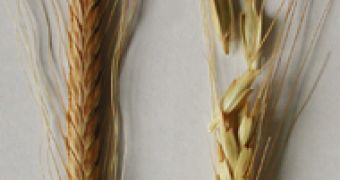One of the most important events in human history was the domestication of plants. This allowed humans to settle and to move from the hunter and gatherer status to an agriculture-based society. However, the advent of agriculture was not the outcome of one genius who managed to understand how plants work and thought about planting the seeds and domesticating crops. The transition from hunter-gatherer to agriculture was very slow and gradual. But how slow and how gradual?
The first crops (wheat and barley) started to be planted about 10,000 years ago in the Fertile Crescent, in today's Iraq, Syria and Turkey. Archaeologists debate the speed at which the domestication of crops then spread from this place across the Near East. Some believe that the potential was immediately understood and agriculture was quickly adopted in other places, while others argue for a much more gradual adoption.
The most interesting argument in favor of the idea of a slow, gradual adoption is that, maybe surprisingly, populations of hunter-and-gatherers have access to much better and secure food supplies than their agricultural counter-parts. This is true even today in the third world, when for instance the Kalahari Bushmen have a much more varied and protein-rich diet than most people living in Botswana's and Namibia's towns and villages. It's highly unlikely for a Kalahari Bushman to suffer from hunger. In other words, agriculture does not seem to have been employed as a sort of genius invention that has suddenly brought unseen prosperity, on the contrary, it seems to have been the last resort of the least successful hunter-and-gatherers. In the beginning, it was a compromise solution, that only later became the source of the population growth and civilization.
A new archeological study has now added strong evidence that this idea of a slow, gradual spread of agriculture is indeed correct. Archaeobotanist George Willcox of the National Center for Scientific Research in Lyon, France, and plant geneticist Ken-ichi Tanno of the Research Institute for Humanity and Nature in Kyoto, Japan, examined nearly 10,000 wheat spikelets - the flowering part of the wheat plant - that were unearthed during archaeological excavations. The researchers focused on four settlements of various ages in northern Syria and southeastern Turkey, where wheat was first domesticated.
They have looked for differences between the wild wheat and the domesticated one. As people planted the wheat, instead of just gathering the wild specimens, they have artificially and unconsciously favored some plants over the other. In time, this led to a differentiation of the domesticated form from the wild form. In the picture above, the left plant is the domesticated wheat and the right plant is wild wheat. From all the uncovered samples, the scientists could only tell for sure whether the spikelets were domesticated or wild in 804 of the samples.
However, the trend was clear: over nearly 3 000 years, the earlier sites had fewer domesticated spikelets, and the later sites had more. At a 10,500 year old site called Nevali ?ori in Turkey, for example, only about 10% of the spikelets were clearly domestic, while 36% were domestic at 8 500 year old el Kerkh in Syria and 64% at 7 500 year old Kosak Shamali, also in Syria. These results suggest that wild varieties were gradually replaced by domestic varieties, and that agriculture was for a long time combined with gathering of wild plants. There wasn't a sudden change from gatherer status to farmer status.
This study has even managed to change the mind of some of the most prominent scientists previously arguing the rapid change theory. Archaeobotanist Gordon Hillman of the Institute of Archaeology at University College London, who was one of the first researchers to suggest a rapid transition from wild plant gathering to farming, said he was "very impressed". However, others still question whether the dataset has been sufficiently large.
Photo credit: George Willcox/CNRS

 14 DAY TRIAL //
14 DAY TRIAL //